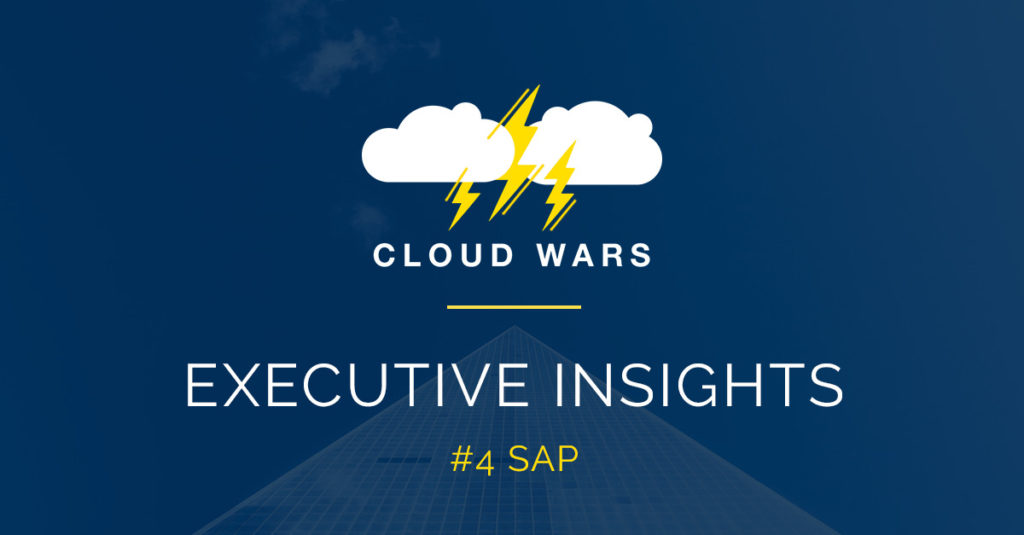Top cloud vendors are buying, building and partnering their way into the booming business for data analytics, data management and data visualization as business customers demand easy-to-use and modern data solutions that support multi-cloud and hybrid-cloud environments.
For those business customers, the rapidly escalating demands of the digital age require enhanced abilities to manage, analyze, secure and exploit all of their data in all of its forms.
For the Cloud Wars Top 10, that means big opportunities to address the complex and at times intractable challenges of data management and utilization. So the vendors are rushing to help businesses:
- gain full access to all their data;
- “reason over” (as Microsoft likes to say) that data without having to be data scientists;
- integrate and unify data models and access across on-premises, public cloud and private cloud;
- secure that data in ways that are consistent and automated across all those formats; and
- offer access for far greater numbers of people in controlled fashion as more people work with and enhance business data.
This whole phenomenon’s clearly been around for a while, but generally involved future plans and possibilities rather than real-world cloud services and technologies.
But all of that changed over the past several weeks with a flurry of developments:
- SAP launched its Data Warehouse Services, including its integrated analytics-as-a-service Analytics Cloud;
- Google Cloud acquired BI and analytics specialist Looker for $2.6 billion;
- three days later, Salesforce acquired data-visualization specialist Tableau for a whopping $15.3 billion, which works out to 40X revenue; and
- a week ago, IBM announced a broad partnership with around data science and data management for advanced analytics and AI.
Let’s take a look at some highlights from each of those initiatives—and I’ve focused on highlighting the customer-side business benefits the cloud vendors expect to deliver. It’s quite a list, which means businesses will certainly stand to gain as this massive data-management segment of the market becomes more competitive, innovative, and business-driven.
SAP Launches Data Warehouse Cloud, which includes Analytics Cloud
In the context of the range of data-related challenges customers are facing today, SAP said at its Sapphire event last month that “Many companies continue to feel overwhelmed by the sheer enormity of the task at hand, with data often remaining siloed, replicated, or even completely untouched. While they recognize the immense opportunity that being a data-driven organization represents, it gets increasingly hard to connect this back to their business and therefore take full advantage of the potential it provides to generate lasting value.”
In response to that gap, SAP introduced its Data Warehouse Cloud to help customers deploy “simple cloud-based end-user analytics” that deliver near-real-time results, are relatively easy to manage, and offer the cloud-based cost advantage of paying for only what’s used. The SAP Data Warehouse Cloud offers pre-built templates, full integration to SAP applications and data stores, and hybrid modes to span cloud and on-premises.

A key element of the Data Warehouse Cloud is the SAP Analytics Cloud, which the company says is part of its “one simple cloud strategy” that helps “businesses plan, discover, analyze, predict, and make decisions all on one unified, intuitive platform that has been designed for the business user.”
Gerrit Kazmaier, senior vice president of SAP HANA and Analytics, said SAP Analytics Cloud is “a critical piece of the Intelligent Enterprise strategy” that will “provide intelligence in context across our portfolio.” The company expects that by the end of 2019, 1.3 million users will be exposed to SAP Analytics Cloud through the company’s cloud line-of-business applications.
Google Cloud Buys Looker to Fulfill CEO Kurian’s Plans to “Move Up the Stack”
In my June 11 analysis of the Google Cloud and Salesforce acquisitions, I offered these perspectives from Google Cloud CEO Thomas Kurian on Looker’s ability to help business customers with analytics, data-management, and essential decision-making:
“The addition of Looker to Google Cloud will help us offer customers a more complete analytics solution from ingesting data to visualizing results and integrating data and insights into their daily workflows. It will also help us deliver industry specific analytics solutions in our key verticals, whether that’s supply chain analytics in retailing; media analytics in entertainment; or healthcare analytics at global scale.”
Plus, supercharging data management:
“A fundamental requirement for organizations wanting to transform themselves digitally is the need to store, manage, and analyze large quantities of data from a variety of sources. Google Cloud offers customers a broad and integrated suite of cloud services to ingest data in real time, cleanse it, process it, aggregate it in a highly scalable data warehouse and analyze it.”
And tools for decision-making:
“Looker extends our business analytics offering with two important capabilities—first, the ability to define business metrics once in a consistent way across data sources. This makes it easy for anyone to query data while maintaining consistent definitions in their calculations, ensuring teams get accurate results. Second, Looker also provides users with a powerful analytics platform that delivers applications for business intelligence and use-case specific solutions such as Sales Analytics, as well as a flexible, embedded analytics product to collaborate on business decisions.”
Salesforce Says Tableau Will Enhance and Accelerate Customers’ Digital Transformations
Salesforce co-CEOs Marc Benioff and Keith Block were equally effusive in announcing the acquisition, as I wrote about earlier this month in Why Google Cloud and Salesforce Are Pumping $18 Billion into Analytics and BI. An excerpt from that piece:
“Tableau helps people see and understand data, and Salesforce helps people engage and understand customers. It’s truly the best of both worlds for our customers–bringing together two critical platforms that every customer needs to understand their world.”
From Salesforce co-CEO Keith Block: “Data is the foundation of every digital transformation, and the addition of Tableau will accelerate our ability to deliver customer success by enabling a truly unified and powerful view across all of a customer’s data.”
From the Salesforce press release announcing the agreement: “Companies of every size and industry are transforming how they do business in the digital age—customers and data are at the heart of those transformations.
“With Tableau, Salesforce will play an even greater role in driving digital transformation, enabling companies around the world to tap into data across their entire business and surface deeper insights to make smarter decisions, drive intelligent, connected customer experiences and accelerate innovation.”
IBM and New Partner Cloudera: Helping Businesses Leverage Big Data Analytics
The Cloudera partnership—which immediately spiked Cloudera’s stock price by 3.5%—is the latest in a series of steps by IBM to help clients use Hadoop “to store and process big data,” said Paul Rivot, strategic alliance executive for IBM Data and AI.
The alliance will also help businesses use tools like Watson Studio “to access data sets, share data, and avoid the cost of building their own integration software processes—and ultimately build new business models more quickly.”
To that, Cloudera vice-president of global channels and alliances Scott Andress added that the partnership will “accelerate data-driven decision-making for our joint enterprise customers who want a hybrid and multi-cloud data-management solution with common security and governance.”
Disclosure: at the time of this writing, SAP, Google Cloud and IBM were clients of Evans Strategic Communications LLC.
Subscribe to the Cloud Wars Newsletter for in-depth analysis of the major cloud vendors from the perspective of business customers. It’s free, it’s exclusive, and it’s great!








